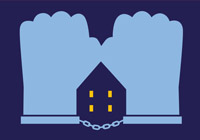There is no single solution to homelessness, no fixed idea of housing that will shelter humanity. As the research in this issue of Blueprint shows, what works in Mumbai may or may not work in Santa Monica. But it’s also clear that different experiences suggest lessons, some of which may travel, and all of which deserve consideration.
Start with the single-family home. Few institutions are more ingrained in Southern California’s sense of itself than that type of home – sometimes with a swimming pool, often part of a sprawling suburb in which neighbors have elbow room. As Professor Paavo Monkkonen notes, roughly three-quarters of Los Angeles is zoned for single-family homes, and they dominate the physical landscape of the city. But as they have grown more expensive, they have thwarted the mobility that once enabled residents in smaller homes to grow into larger ones; political factors – homeowner associations and other forces of homeowner activism – have helped lock the status quo in into place, and mobility has slowed down.
That creates a multi-dimensional obstacle, but it is being addressed. Some cities such as Seattle and Portland are promoting higher-density housing, and even Los Angeles is experimenting with transit-oriented development. L.A. is nowhere near giving up on the single-family home, but intelligent zoning, based on research by Monkkonen and others, may blunt some of its negative effects.
Lessons come from farther afield, too. Half the population of Mumbai lives in slums. That is no solution for Los Angeles, but Mumbai’s improvised dwellings offer benefits that L.A.’s homeless encampments do not. They are semi-permanent – some have existed since the 1940s – and they offer stability, if not comfort. Reflecting on those observations, Professor Vinit Mukhija says local leaders should improvise along the way to finding permanent solutions to homelessness. He suggests converting parking lots or and other open spaces into safe housing areas for the very poor. If leaders listen, Mumbai may in fact have spoken to L.A.
There is resistance. Sadly, the poor often frighten the middle-class. One canard is that housing assistance for poor people in middle-class neighborhoods brings crime. Professor Michael Lens has discovered that it’s not true. His research speaks to the value of the federal government’s Section 8 housing assistance program, which helps subsidize poor people outside of public housing. But the impact of the Section 8 program is limited by the funds allocated to it. Policy makers interested in taking advantage of its benefits need to consider whether to increase its funding, how to connect its benefits to public transportation and how to disabuse residents of their fear that larger subsidies will result in more crime.
Then there are those issues that test the limits of policy solutions. Gentrification, for instance, has created a paradox for those affected by it. The soaring value of homes in places such as Boyle Heights creates new wealth – and potential windfalls for homeowners who have long held property in the area. But it also creates pressure on those neighborhoods, ripping apart old connections and traditions. Professor Chris Zepeda-Millan describes how this has been a call to activism. It should also be a call, he says, for government and private services to assist those forced out of their homes and apartments because of rising prices.
These are among society’s toughest issues. It hurts the soul to allow people to remain homeless, and it hurts society to price working people out of decent homes. No one solution will suffice. Together, however, the work reviewed in these pages may suggest some ways forward.
























